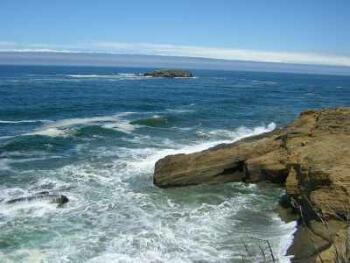
Publisher:
Bonnie King
CONTACT:
Newsroom@Salem-news.com
Advertising:
Adsales@Salem-news.com

~Truth~
~Justice~
~Peace~
TJP
Aug-09-2006 23:00

 TweetFollow @OregonNews
TweetFollow @OregonNews
Oregon One Step Closer to Offshore Ocean Observing System
Salem-News.comOSU will operate the project, known as the Oregon Coastal Ocean Observing System, or OrCOOS, which would provide some of the first coordinated “real time” oceanographic data from Oregon’s coastal waters.
 Photo by: Matt King |
(CORVALLIS) - Oregon’s long-awaited offshore ocean observing system has moved one step closer to reality after the U.S. Senate Commerce-Justice-State Appropriations Subcommittee, which approved its 2007 spending bill, proposed $2 million for the project.
The bill still needs to pass through the senate floor, and then go to conference with the U.S. House of Representatives – likely in December.
Scientific data from ocean observations is recorded through many different projects, but it lacks coordination and timeliness, said Mark Abbott, dean of the College of Oceanic and Atmospheric Sciences at OSU. Establishing OrCOOS would provide real time data that would benefit not only scientists, Abbott pointed out, but also the state’s commercial and recreational fishing fleets, the Coast Guard and other marine operations, natural resource managers, students and educators, and others.
“The model is the National Weather Service, which collects data from a variety of different sources and makes is available broadly to a variety of users,” Abbott said. “The real time data we would receive from wave observations and forecasts, for example, will be of use to recreational boaters trying to determine when to cross the bar, and to the Coast Guard to estimate where a ship will drift in the ocean after it has lost its power.
“It’s something that will benefit the state of Oregon – and it’s long overdue,” Abbott said.
U.S. Sen. Gordon Smith has been an advocate for the ocean observing system and helped steer last year’s initial funding of $450,000 for the project. A team of scientists led by OSU oceanographer Jack Barth used the funding to develop a new research buoy that will be moored off Heceta Bank along the central Oregon coast.
The sophisticated instrumentation aboard the buoy will measure chlorophyll levels in the water that indicate biological productivity; dissolved oxygen that relates to hypoxia or “dead zones,” temperature, salinity and current velocity. Above water, the buoy will take a full meteorological scan, measuring air temperature, wind speed and solar radiation.
The above-water portion of the buoy is even fenced to prevent sea lions from lounging on – and potentially sinking – the buoy.
“The Heceta Bank is one of the most important locations along the coast because it deflects the waters flowing from the north and creates a quiet pool of water that serves as an incubator for the phytoplankton that feed the marine food web,” Barth said. “That’s also the location of the most intense hypoxia events and ‘dead zones.’
“Oregon is situated at a point where changes in the atmospheric Jet Stream have a major impact on the local weather conditions and the ocean’s response to them.”
Barth said the $2 million appropriation under consideration in Congress would be used to develop two additional buoy systems – one that would be deployed off the Columbia River and the other off Coos Bay.
“That would give us tremendous coverage of the entire Oregon coast,” he said.
The funding also would help the scientists design models that will predict ocean conditions based on their observations and analyses of data from the buoys and other sources, and create user-information systems for fishermen, recreational boaters, and others.
Articles for August 8, 2006 | Articles for August 9, 2006 | Articles for August 10, 2006
Quick Links
DINING
Willamette UniversityGoudy Commons Cafe
Dine on the Queen
Willamette Queen Sternwheeler
MUST SEE SALEM
Oregon Capitol ToursCapitol History Gateway
Willamette River Ride
Willamette Queen Sternwheeler
Historic Home Tours:
Deepwood Museum
The Bush House
Gaiety Hollow Garden
AUCTIONS - APPRAISALS
Auction Masters & AppraisalsCONSTRUCTION SERVICES
Roofing and ContractingSheridan, Ore.
ONLINE SHOPPING
Special Occasion DressesAdvertise with Salem-News
Contact:AdSales@Salem-News.com

googlec507860f6901db00.html



Terms of Service | Privacy Policy
Comments are Closed on this story.
[Return to Top]
©2025 Salem-News.com. All opinions expressed in this article are those of the author and do not necessarily reflect those of Salem-News.com.